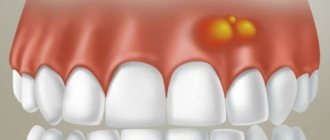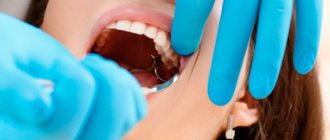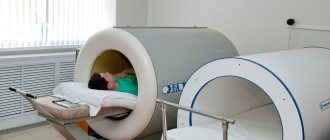Alveolitis is an acute infectious inflammation of the tooth socket.
caused by surgery. It is accompanied by acute pain in the extraction area, increased local temperature, enlarged lymph nodes, as well as a specific putrid odor from the oral cavity.
In the absence of adequate and timely diagnosis, alveolitis develops into limited osteomyelitis
with all the ensuing consequences. Therefore, it is very important, immediately after the onset of symptoms, to carry out high-quality sanitation of the hole and provide treatment.
Fibrosing alveolitis
This type of pathology is notable for the fact that connective tissue develops to replace the necrotic residue of the hole left after tooth extraction. In principle, many dentists propose to consider fibrosing alveolitis not as a separate type of this nosology, but as one of the stages of its course, which is characterized by a slight decrease in the intensity of the manifestations of the inflammatory reaction and partial stabilization of the general condition of the patient. If you take a closer look at the condition of the oral cavity, you will notice a slight proliferation of soft tissues adjacent to the hole in which the pathological process occurs. The formation of a gap between the soft tissues and the hard, bone wall is also typical in this situation.
Causes of alveolitis
The main reason for the development of the disease is the patient’s failure to comply with personal oral hygiene. In addition, there are a number of other reasons:
- Chronic gum inflammation;
- The appearance of plaque on the teeth;
- Carious teeth that are located next to the tooth;
- Weak immune system;
- Unremoved tissue in the depths of the hole;
- Eating hard and spicy foods after tooth extraction.
In some cases, the disease can affect the respiratory tract. Do not delay treatment, it is important to us that you remain healthy. Pay attention to the condition of your teeth, because the condition of the entire body depends on them. Make an appointment at our clinic or schedule a consultation with your dentist.
Allergic alveolitis
When compounds that cause a pathological reaction in the form of an allergy enter the human body, not only the respiratory tract and the mucous membrane of the eyes react - swelling and soreness of the dental alveoli with the subsequent formation of an inflammatory process can sometimes also be noted. Accordingly, all these changes can safely be called allergic alveolitis, because their pathogenesis is based on the same antigen-antibody reaction.
This type of pathology is manifested by constant aching pain, which intensifies significantly during food consumption. Quite rightly, allergic alveolitis is recognized as one of the “mildest” forms of this disease, because it is not accompanied by a pronounced clinical picture. Usually the patient's general condition is relatively satisfactory, there is no fever. Upon careful examination of the hole left after tooth extraction, one can note the almost complete absence or insufficient amount of a protective blood clot. Remnants of food are usually visible here. It may also be that allergic alveolitis forms after 2-3 days from the moment of tooth extraction. And if timely treatment is not started, the prognostically favorable form of the disease can lead to serious complications.
Methods for diagnosing alveolitis
It is not difficult to see signs of alveolitis after removal of an upper wisdom tooth with the naked eye: the absence or small size of a blood clot will immediately indicate a violation of the healing process. An x-ray will help clarify the causes of this phenomenon. If traces of the roots of an extracted tooth or other foreign inclusions are noticeable in the wound, the problem can only be dealt with if they are completely removed. Based on the exact reasons for the development of the pathology, the doctor develops a treatment course and gives the patient recommendations that must be followed.
Idiopathic alveolitis
If alveolitis has already developed, then you need to rush to take action, and not find out the reason why this happened. Yes, this is one of the diseases in which understanding the pathology of the process is not of primary importance, because regardless of what exactly caused the pathological process, treatment regimens will differ little from each other. The tactics of patient management are determined not by the origin of alveolitis, but by the severity of clinical symptoms.
It is not a fact that alveolitis arose due to a medical error - individual anatomical features could be the only factor that provoked the occurrence of such a situation. Take, for example, the same alveolitis after the extraction of a wisdom tooth - due to the difficulties with removing the “eights” itself, the likelihood of complications occurring is quite high. By the way, it is precisely the anatomy of the root system of wisdom teeth that causes the removal of a dental cyst most often to be carried out on the eighth molars.
Exogenous alveolitis
A persistent febrile condition is characteristic; throughout the entire disease there is pronounced pallor of the skin. The patient's quality of life deteriorates significantly - he cannot eat properly, because it becomes very difficult to eat.
Lymphangitis and lymphadenitis are characteristic signs of exogenous alveolitis, because the infection quickly spreads to nearby areas. Upon visual examination, a gray coating and severe hyperemia are noted, and upon palpation the patient notes sharp pain.
Symptoms of alveolitis development
The inflammatory process develops several days after the operation. At the very beginning, the symptoms are very mild:
- redness and slight soreness of the gums;
- absence of a blood clot and filling of the hole with leftover food;
- pain while eating.
As the disease progresses, quite specific symptoms appear:
- increasing pain;
- the appearance of gray plaque in the hole;
- swelling of the face;
- enlarged lymph nodes, discomfort when palpating them;
- purulent discharge from the socket;
- increased body temperature;
- severe swelling and redness of the gums.
The pain becomes stronger and can spread from the gums to the temples and also radiate to the ear. The appearance of purulent discharge indicates the development of a severe stage of the disease. The presence of pus in the hole is dangerous for the entire body, since over time it will cause intoxication, which will manifest itself as poor health, weakness, low body temperature, nausea, etc.
Post-extraction alveolitis
In this case, the name of the pathology indicates its direct origin - it is easy to guess that post-extraction alveolitis develops as a result of unsuccessful (complicated) tooth extraction. This variant of alveolitis involves inflammatory tissue damage not only to the socket itself, but also to the adjacent gum. The statistics of complications is impressive - even taking into account the potential of modern medicine, the incidence of post-extraction alveolitis is about 40% of cases, and most of them are associated with interventions performed on the lower molars.
The clinical picture of post-extraction alveolitis occurs 2-3 days after tooth extraction. Symptoms can be conditionally classified into two variants of manifestations - symptoms of general and local significance. Alveolitis necessarily has symptoms from both the first and second categories.
The first category includes:
- Low-grade or febrile fever.
- Lymphangitis and lymphadenitis (regional);
- Halitosis.
Manifestations related to the second category are:
- Local hyperemia and swelling.
- Lack of protective blood clot.
- The presence of a gray coating on the hole.
- Separation of pus.
- Local pain syndrome.
In this case, alveolitis treatment requires primarily symptomatic treatment.
An important point that must be taken into account when diagnosing post-extraction alveolitis - for the reason that the possibility of provoking the development of the disease by the remaining piece of tooth cannot be excluded, the patient must be referred for an x-ray. It may be that even if alveolitis develops, the symptoms of this disease do not indicate the presence of pathology for a certain period of time.
Many patients consider the occurrence of alveolitis to be solely the fault of the doctor, because there are articles that write that the socket can become inflamed as a result of improperly carried out preventive measures after tooth extraction. Yes, such cases happen, but not in the Academy Dent clinic - the use of modern techniques, coupled with the highest professionalism of our doctors, allows pain relief and removal without any consequences for the patient.
The worst option is when the tooth is not completely removed and some part of its root remains in the socket. This situation, without a doubt, is the fault of the doctor, because he was not convinced that the intervention was performed correctly and did not study the anatomy of the root system of the tooth using an x-ray. Severe purulent inflammation develops - body temperature rises, purulent discharge with an unpleasant odor is noted. The patient complains of a specific sensation of something sweet in the mouth - but in fact, the inflammatory process is to blame. Therefore, it is very important to ensure that after tooth extraction there are no foreign bodies left in the socket - in this case, their imperceptible resorption by cells of the immune system is a priori impossible.
The process in question, which occurs in one place, can easily inflame several adjacent holes, as a result of which eliminating the problem will become much more difficult. It will be necessary to drain the purulent lesion and use strong antibiotics administered orally. Alveolitis often requires surgical treatment, with dissection of the adjacent subcutaneous fat.
Alveolitis after tooth extraction treatment
Key task
in the treatment of dental alveolitis, is to effectively
combat the infectious focus
, as well as prevent further development and spread of infection to neighboring tissues.
Before treating alveolitis after tooth extraction, the dentist must conduct a comprehensive examination, determine the degree of development of the problem and develop an optimal treatment regimen that provides maximum effectiveness and a minimum level of trauma to surrounding tissues. Treatment in progress
, the doctor performs mechanical cleansing of the hole from infected tissues:
purulent residues are removed
by washing with antiseptic agents.
To eliminate pain and stop infectious inflammation, local applications with anesthetics and analgesics are used. Lotions are applied to the affected area for a limited time, usually 30 minutes. They have a positive effect on the problem area, preventing the proliferation of pathogenic microflora. If necessary, the procedure is repeated several times a day until the problem is completely eliminated.
Tablet analgesics are not used due to the need to take very large dosages - lotions are more effective
, they have minimal impact on the organs and systems of the body. But, with the development of concomitant diseases or decreased immunity, antibiotic therapy may be prescribed - in this case, the process of taking the drugs is strictly controlled by the attending physician.
Treatment of alveolitis
Treatment of alveolitis, regardless of its etiology, is a very difficult task, the solution of which clearly requires professional medical care. In no case should you act independently and at home, because with an illiterate approach there is a high chance of causing significant harm.
Conditionally, the treatment of alveolitis can be classified into stages - depending on how timely the alveolitis was diagnosed, the treatment and general management tactics are determined.
Early treatment
If alveolitis was diagnosed in the initial stages, then to get rid of the disease it is sufficient to perform the following measures:
- The implementation of drug anesthesia is primarily because, despite its relative simplicity, the process of getting rid of alveolitis is quite painful.
- Treatment of the hole in which there is an inflammatory process is washed with an antiseptic solution.
- Removing necrotic debris from the socket.
- Repeated treatment of the hole with an antiseptic followed by drying with gauze.
- Placement on top of fabric soaked in antiseptic and drugs that provide an anesthetic effect.
- Apply applications with antiseptics daily (for a week) in order to eliminate the possibility of a relapse of the inflammatory reaction.
How does dental alveolitis manifest?
After tooth extraction, you may not notice the onset of alveolitis. This disease spreads at a high speed and delay in its treatment leads to inflammation of deep tissues. If after 2 days you begin to feel:
- Discomfort in the tooth socket;
- Pain while eating;
- Unpleasant feelings when opening the mouth;
- Headaches and malaise;
- High temperature;
- Swelling of the gums;
- Putrid odor from the mouth.
If these symptoms occur, you should immediately contact your dentist. If not treated in a timely manner, the area of inflammation takes on a bluish tint and the process of tissue death occurs.
Types of dental alveolitis
Depending on the manifestation of symptoms, there are 3 types of alveolitis:
- Serous alveolitis. It manifests itself as constant aching pain. While eating, the pain intensifies significantly. Lymph nodes and body temperature are normal. This condition lasts a week, after which the acute stage of the disease begins.
- Purulent alveolitis. Due to purulent discharge, intoxication of the body occurs. Malaise and increasing pain appear. The gums and face swell, it becomes difficult to open the mouth.
- Hypertrophic alveolitis. A chronic form of the disease that manifests itself sluggishly. Almost all symptoms are absent. The gums become blue and pus flows out of it. When examined by a doctor, the proliferation of affected tissues is diagnosed.











